How to Grow Ginger: Essential Tips for a Bountiful Harvest
- February 28, 2024
- 0 comment
Ginger, known scientifically as Zingiber officinale, is a flowering plant whose rhizome, ginger root, is widely used as a spice and a folk medicine. It’s a plant that can bring a tropical flair to your garden or indoor space. Plus, it’s satisfying to grow your own ginger for cooking and tea. Here’s a comprehensive guide on how to cultivate ginger in your own space.

Nutritional Benefits of Ginger
| Benefit | Description |
|---|---|
| Digestive Health | Ginger can help in alleviating gastrointestinal irritation, stimulating saliva, and suppressing gastric contractions as food and fluids move through the GI tract. |
| Nausea Relief | Effective in reducing nausea caused by morning sickness during pregnancy, chemotherapy, or after surgery. |
| Anti-Inflammatory Effects | Contains gingerol, which has powerful anti-inflammatory and antioxidant effects. |
| Pain Reduction | May reduce muscle pain and soreness due to its anti-inflammatory properties. |
| Lower Risk of Heart Disease | May have powerful benefits for your heart, including lowering blood pressure and preventing heart attacks. |
| Lower Blood Sugar Levels | Studies suggest ginger may have powerful anti-diabetic properties. |
| Cholesterol Level Management | Can significantly reduce LDL cholesterol and triglyceride levels. |
| Cancer Prevention | Some studies suggest that ginger could be effective against certain types of cancer. |
| Improved Brain Function | The antioxidants and bioactive compounds in ginger can inhibit inflammatory responses that occur in the brain. |
| Fighting Infections | Gingerol can help lower the risk of infections and can inhibit the growth of many different types of bacteria. |
Choosing Your Ginger
Selecting the Right Rhizome
When you’re on the hunt for the perfect ginger rhizome to plant, there are a few key things to keep in mind:
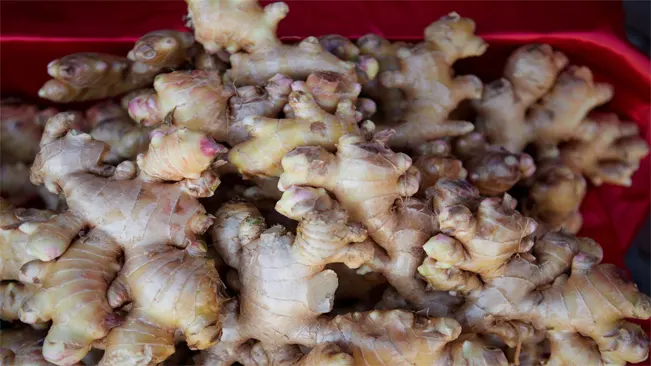
- Appearance: Look for ginger rhizomes that have a plump, smooth skin. They should feel firm and heavy in your hand. Avoid rhizomes that are wrinkled or have signs of mold or rot.
- Growth Buds: The most important feature to look for are the ‘eyes’ or growth buds. These are small nodes, somewhat similar to the eyes on potatoes, from which the new growth will sprout. Choose a rhizome with well-developed and prominent growth buds. The more buds, the better the chances of successful sprouting.
- Freshness: Fresher ginger rhizomes are more likely to sprout and grow well. Fresh ginger will have a bright, spicy aroma and a firm texture. Older rhizomes that have been stored for a long time may have reduced viability.
- Size: While size isn’t a direct indicator of health or viability, larger pieces can be more forgiving to beginner gardeners. They have more resources (stored starch and energy) to support initial growth.
Organic Matters
Opting for organic ginger can be significant for a few reasons:
- Growth Retardants: Non-organic ginger is often treated with growth retardants to extend its shelf life in supermarkets. These chemicals can inhibit sprouting when you try to plant them. Organic ginger is less likely to have been treated with these substances.
- Pesticides and Chemicals: Organic ginger is also free from harmful pesticides and chemicals. While this is generally a health consideration when consuming ginger, it also means the plant is starting off in a more natural and healthy state when you plant it.
- Quality and Taste: Some gardeners and chefs believe that organic ginger offers superior quality and taste, which can translate into more robust plants and better harvests.
Where to Buy
- Garden Centers and Nurseries: These are ideal places to buy ginger for planting because they often offer varieties that are specifically meant for gardening.
- Online Stores: There are many reputable online retailers and gardening sites that sell high-quality ginger rhizomes suitable for planting.
- Grocery Stores: While convenient, be cautious when buying from grocery stores as these rhizomes might be treated with growth retardants. If choosing from a grocery store, organic is the way to go.
Preparing for Planting
Soaking
The practice of soaking ginger rhizomes before planting is particularly important if you suspect the ginger has been treated with growth retardants, which is often the case with ginger purchased from grocery stores. These retardants are used to prevent the ginger from sprouting prematurely. Here’s how you go about it:
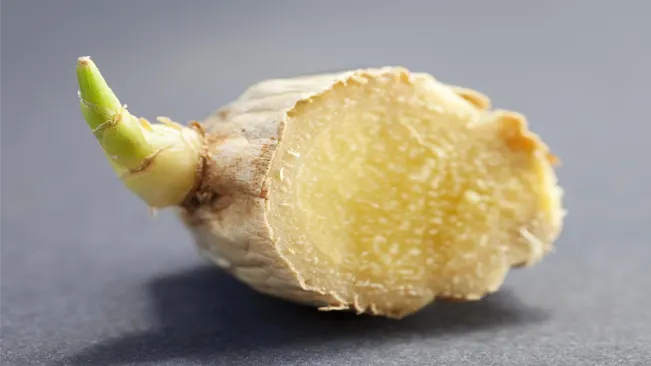
- Why Soaking is Important: The soaking process helps to leach out some of these chemicals, thereby increasing the chances of your ginger successfully sprouting.
- How to Soak: Simply place your ginger rhizome in a bowl of room temperature water and leave it overnight. This duration is generally sufficient to reduce the concentration of any growth inhibitors.
- Water Change (Optional): You can change the water once or twice during the soaking process to further help remove the chemicals.
- Post-Soaking Preparation: After soaking, remove the ginger from the water and pat it dry. It’s now ready for the next stage, which is cutting, if necessary.
Cutting
If your ginger rhizome is large, you might want to cut it into smaller pieces. This is not only economical but also allows you to grow multiple plants. Here’s the process:

- Identifying Growth Buds: First, identify the ‘eyes’ or growth buds on your ginger. These are small nodes, somewhat similar to those on potatoes, from which the new growth will sprout.
- How to Cut: Using a sharp, clean knife, cut the ginger into pieces, ensuring each piece has at least one growth bud. The pieces should be roughly 1-2 inches in size.
- Drying and Callusing: After cutting, lay the pieces out in a dry, well-ventilated area. The aim is to allow the cut surfaces to dry and form a callus over a period of one to two days. This step is crucial as it helps prevent rot and fungal infections when planted.
- Avoiding Direct Sunlight: During the drying process, avoid placing the ginger pieces in direct sunlight. A shady, airy spot is ideal.
- Planting Readiness: Once a callus has formed, the ginger pieces are ready to be planted.
Planting Your Ginger
Ginger plants have a horizontal growth pattern, which means they spread outwards more than they grow deep. This growth habit makes wide, shallow pots ideal for planting ginger. Here are some key points to consider when selecting a container:
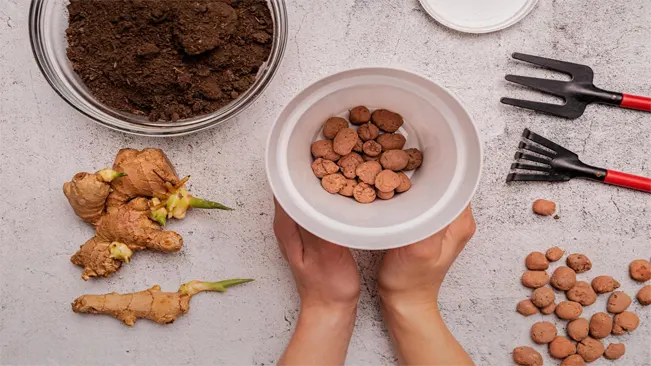
- Size: A pot that is at least 12 inches deep and 12 to 18 inches wide is recommended. This size provides enough space for the ginger to spread.
- Material: Containers can be made of plastic, terracotta, or even wood. Each material has its pros and cons in terms of weight, breathability, and moisture retention.
- Drainage: Good drainage is crucial. Ensure the pot has adequate drainage holes at the bottom. Poor drainage can lead to waterlogging, which might cause the rhizomes to rot.
Soil Requirements
The right soil mix is essential for healthy ginger growth. Consider these points:

- Texture: The soil should be well-draining yet able to retain some moisture. A loamy soil that is rich in organic matter is ideal.
- pH Level: Ginger prefers slightly acidic to neutral pH levels, typically between 5.5 and 6.5. You can easily test the soil pH using a home testing kit.
- Nutrients: Enrich the soil with well-rotted compost or aged manure before planting. This will provide the ginger with the necessary nutrients as it grows.
- Avoid Soil Compaction: Compacted soil can hinder root growth. Ensure the soil is loose and airy.
Planting Depth and Orientation
Proper planting is vital for the successful growth of ginger. Here’s what to keep in mind:
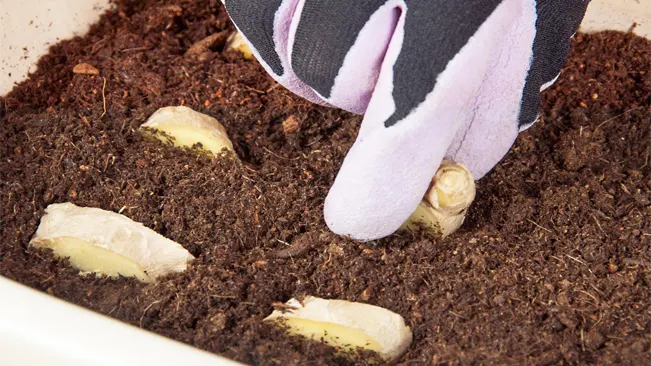
- Depth: Plant the ginger rhizomes about 1-2 inches deep. Planting them too deep can delay germination, while too shallow planting can expose the rhizomes.
- Orientation: The growth buds or ‘eyes’ of the ginger should face upwards. This is where the shoots will emerge. If it’s not clear which way is up, laying the rhizome horizontally is also fine, as the shoots will find their way up.
- Spacing: If planting multiple rhizomes, leave a few inches of space between each piece to give them room to grow.
- Initial Watering: After planting, water lightly to settle the soil around the rhizomes.
Caring for Your Ginger Plant
Light
- Filtered, Indirect Sunlight: Ginger plants thrive in an environment that mimics their natural tropical habitat. They prefer light that is bright yet indirect. Direct sunlight, especially in hotter climates, can scorch the leaves of the plant.
- Shading Techniques: If you’re growing ginger outdoors and live in a particularly sunny area, consider using shade cloth to protect the plants during the hottest part of the day.
Watering

- Consistent Moisture: Ginger plants require soil that is consistently moist. This doesn’t mean waterlogged or overly soggy, as this can lead to root rot. Instead, aim for a soil consistency similar to a wrung-out sponge.
- Humidity: Since ginger is a tropical plant, it thrives in a humid environment. If you’re growing ginger indoors, especially in drier climates, misting the plant can help increase the humidity around it. Placing a tray with water and pebbles under the pot can also aid in increasing humidity.
Temperature
- Warmth is Key: Ginger plants prefer temperatures in the range of 75 to 85 degrees Fahrenheit (24 to 29 degrees Celsius). They can tolerate a bit of fluctuation but don’t fare well in cold conditions.
- Winter Care: If you live in a region with cold winters, it’s crucial to bring your ginger plant indoors or provide sufficient protection if it’s planted in the ground.
Feeding
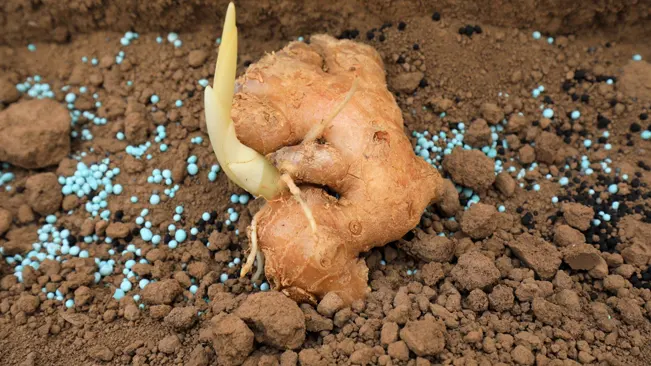
- Balanced Fertilization: Use a balanced liquid fertilizer to nourish your ginger plant. This should be done every few weeks during the active growing season (spring and summer).
- Overfeeding Caution: Be cautious not to over-fertilize, as this can harm the plant. Following the instructions on the fertilizer’s label is usually a safe bet.
Pest Control
- Common Pests: Ginger plants can be susceptible to pests such as aphids, spider mites, and mealybugs. Regular inspection of your plant can help catch infestations early.
- Natural Remedies: You can often manage these pests by rinsing the plant with water or using a mild soap solution. In more severe cases, neem oil can be an effective organic treatment.
Additional Tips
- Mulching: Applying a layer of organic mulch around the base of the plant can help retain soil moisture and regulate temperature.
- Regular Inspection: Regularly check your ginger plant for signs of stress, such as yellowing leaves or stunted growth, and adjust care as necessary.
- Potting and Repotting: If you’re growing ginger in a container, ensure it’s large enough to accommodate growth. Repotting may be necessary as the plant grows.
Harvesting Your Ginger
When to Harvest Ginger

- Time Frame: Typically, ginger plants are ready to be harvested about 8-10 months after planting. The maturity of ginger can be somewhat flexible depending on your needs.
- Signs of Maturity: You’ll know your ginger is ready to harvest when the leaves begin to turn yellow and die down. This usually happens in late summer or early autumn. The longer ginger grows, the larger and more pungent the rhizomes become.
- Partial Harvesting: If you’re eager to use fresh ginger, you can do a partial harvest 4-6 months after planting. At this stage, the ginger will be less pungent and have a milder flavor. This is often referred to as “baby ginger.”
- Full Harvest: For fully matured ginger, wait until most of the leaves have died down. This ginger will be more flavorful and store better.
How to Harvest Ginger
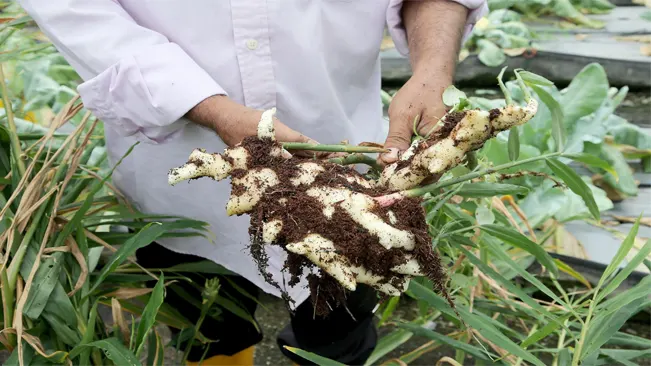
- Preparation: Before harvesting, water your ginger plant to soften the soil. This makes the harvesting process easier and less damaging to the plant.
- Technique: Carefully dig around the edges of your plant using a garden fork or a trowel. Be gentle to avoid cutting into the rhizomes.
- Harvesting Rhizomes: Once you’ve exposed the edges of the ginger rhizomes, you can gently lift them from the soil. If you’re doing a partial harvest, cut off the desired amount of ginger while leaving the rest of the plant intact.
- Post-Harvest Care: After harvesting, rinse the ginger rhizomes to remove soil. Dry them in a cool, shaded area before storing.
- Continued Growth: If you leave some of the rhizome and the roots undisturbed, the plant can continue to grow and produce more ginger. This way, you can have a continuous supply.
Storing and Using Your Ginger
Storing Your Ginger
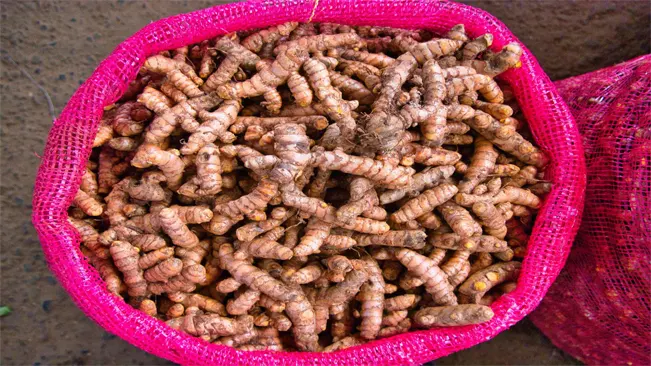
Refrigerator Storage
- Whole, Unpeeled Ginger: Store the whole, unpeeled ginger root in a plastic bag in the crisper drawer of your refrigerator. This method can keep ginger fresh for several weeks.
- Peeled or Cut Ginger: If you’ve already peeled or cut the ginger, blot it dry with a paper towel, and then store it in a tightly sealed container or plastic bag with minimal air in the fridge. It’s best used within a week or two.
Freezer Storage
- Freeze Whole: You can freeze whole ginger roots. To use, grate the required amount while it’s still frozen, and return the rest to the freezer.
- Freeze in Portions: Cut the ginger into chunks and freeze them on a tray. Once frozen, transfer them to a freezer-safe bag or container. This way, you can take out just the amount you need.
Drying and Making Powder
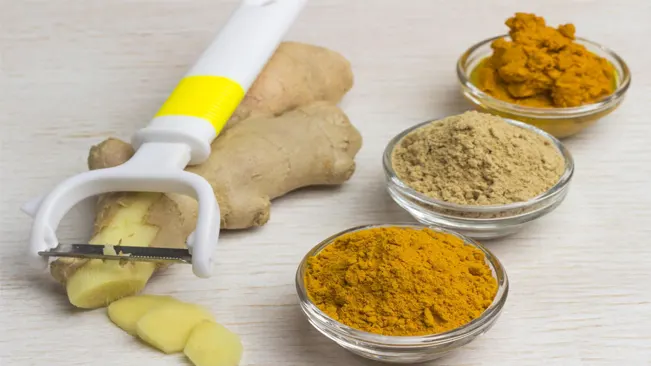
- Drying: Slice the fresh ginger and dry it in the sun, a food dehydrator, or an oven at a low temperature. Store the dried ginger in an airtight container in a cool, dark place.
- Making Ginger Powder: Grind the dried slices into powder using a spice grinder. Store the ginger powder in an airtight container. This can be a great way to preserve ginger for a long duration.
Using Your Ginger
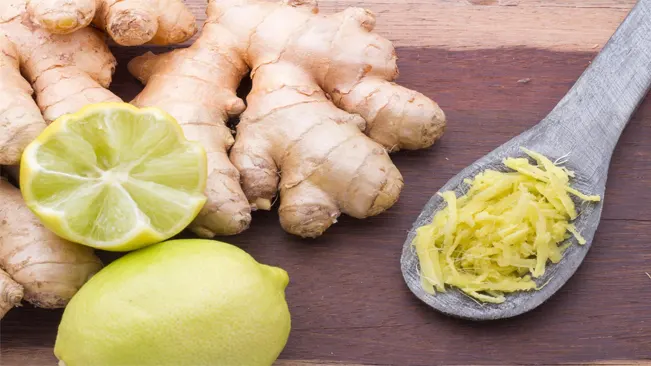
Cooking
- Fresh Ginger: Use it in stir-fries, soups, curries, and marinades. Fresh ginger adds a zesty, spicy flavor to recipes.
- Dried Ginger and Powder: Use in baking (like gingerbread), spice blends, and to flavor sauces and sweets. Ginger powder is more concentrated, so use it in smaller quantities.
Making Tea

- Ginger Tea: Steep a slice of fresh or dried ginger in boiling water for a soothing tea. You can add honey, lemon, or mint for extra flavor.
Natural Remedies
- Digestive Aid: Ginger is known to aid digestion. Chew a small piece or drink ginger tea to help with digestive issues.
- Nausea Relief: Sipping ginger tea can help alleviate nausea.
Beauty and Wellness
- Ginger in Skincare: Ginger’s anti-inflammatory properties make it a great natural ingredient for homemade skincare remedies.
- Hair Care: Ginger oil or a rinse made from ginger-infused water can stimulate hair growth and control dandruff.
Conclusion
Growing ginger at home is a rewarding experience. Not only does it add a tropical aesthetic to your home, but it also provides you with a fresh, flavorful, and healthy ingredient. With patience and proper care, you can enjoy the many benefits this versatile plant has to offer. Happy gardening!
FAQs (Frequently Asked Questions)
- Can I grow ginger from store-bought ginger?
Yes, you can. Choose a fresh piece with visible eyes or growth buds. Organic ginger is preferable as it’s less likely to have been treated with growth retardants. - How long does it take to grow ginger?
Ginger typically takes about 8-10 months to mature fully. However, you can harvest small pieces as early as four months after planting. - Does ginger need full sun to grow?
No, ginger prefers partial shade or filtered sunlight. Too much direct sun can scorch the leaves. - How much water does ginger need?
Ginger likes consistently moist soil but not waterlogged. Water it deeply and allow the topsoil to dry out slightly before watering again. - What type of soil is best for growing ginger?
Ginger grows best in rich, well-draining soil. It prefers a slightly acidic to neutral pH. - Can I grow ginger indoors?
Yes, ginger can be grown indoors. Place it in a spot that receives indirect sunlight and maintain a warm, humid environment. - When is the best time to plant ginger?
The best time to plant ginger is in the spring after the last frost, as ginger requires warm temperatures to thrive. - How deep should I plant ginger rhizomes?
Plant ginger rhizomes about 1-2 inches deep with the growth buds pointing upward. - How do I harvest ginger?
Gently dig around the plant and cut off the amount of ginger you need, being careful not to damage the rest of the plant. The plant will continue to grow. - Can ginger be grown in containers?
Yes, ginger can be successfully grown in containers. Use a wide, shallow pot and ensure it has good drainage.

Kristine Moore
Forestry AuthorI'm Kristine Moore, a seasoned garden landscaping professional with over 30 years of experience. My extensive career has been dedicated to transforming outdoor spaces into stunning, sustainable landscapes. With a deep understanding of horticulture, design principles, and environmental stewardship, I have become a respected figure in the field, known for creating harmonious, visually appealing, and eco-friendly gardens. My commitment to excellence and continuous learning in landscaping trends and techniques has solidified my reputation as an expert in garden design and implementation.








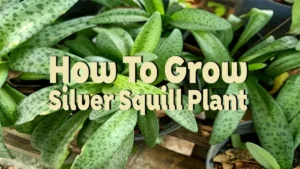




Leave your comment